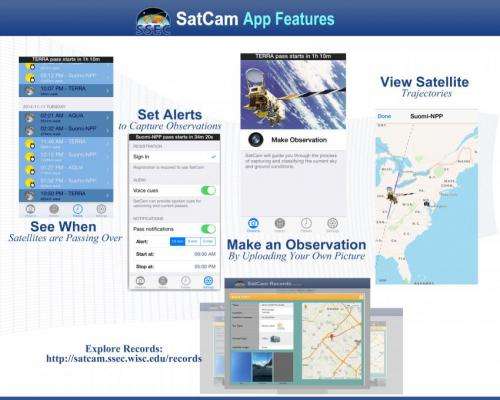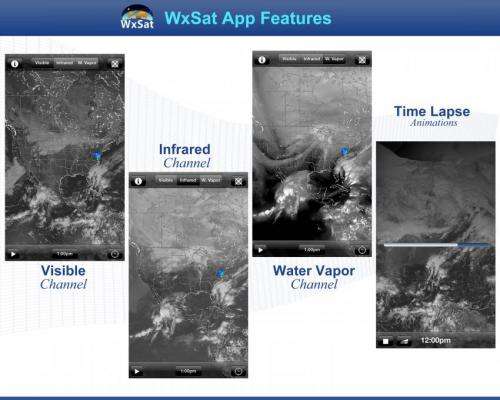Weather and environmental satellite crowd sourcing: Two new apps

National Oceanic and Atmospheric Administration (NOAA)'s academic partner, the Space Science and Engineering Center (SSEC) at the University of Wisconsin-Madison has developed two free mobile apps that bring the ability to see and capture satellite data to mobile users' fingertips. The apps received development support from NOAA and NASA.
The SatCam app for iOS devices allows mobile users to capture observations of sky and ground conditions at the same time that an Earth observing satellite is overhead. The WxSat (short for Weather Satellite) app, for iOS and android, displays and animates full-resolution, real-time weather satellite data. WxSat leverages the SSEC Data Center holdings to provide global coverage for visible, infrared, and water vapor channels.
How SatCam Works
When users capture a SatCam observation and submit it to the SatCam server, it helps to check the quality of the cloud products that are created from satellite data. In return for the observation submission, SatCam sends users the satellite image that was captured at their location. The SatCam software supports NASA's Terra and Aqua satellites as well as the NOAA/NASA Suomi-NPP satellite. SatCam images help SSEC to perfect the cloud mask products that are applied to data collected from the satellites. Cloud mask indicates whether a given view of the Earth is obstructed by clouds or aerosol and can be misinterpreted when cloud temperature is too similar to ground temperature.
"SatCam is a great example of a citizen science app that allows anyone with an iPhone to help improve the data products from instruments onboard three flagship Earth science missions," said Steve Graham, a senior outreach specialist for Global Science and Technology, Inc. at NASA's Goddard Space Flight Center, Greenbelt, Maryland. He has also been the outreach coordinator for the Aqua mission (formerly PM-1) since March 2000.
How WxSat Works
Geostationary and polar orbiting weather satellites, like Suomi-NPP, continuously capture observations of the earth. Data from these satellites are acquired by the SSEC Data Center which has one of the most extensive collections of real-time and archived weather satellite data in the world. WxSat blends those images into single hourly global composites for three different products (Visible, Infrared, and Water Vapor) and is updated every hour at 36 minutes past the hour.
The names of the different images in the WxSat app refer to the parts of the electromagnetic spectrum from which the satellite sensors are sampling. The three most widely used atmospheric channels are the visible, infrared, and water vapor. NOAA forecasters combine information from the three types of images to predict weather, monitor forest fires, ice flows, ocean currents, and long term climate patterns from a global perspective that only satellites can provide.

These SSEC apps are freely available to all interested users. To download and learn more about the SatCam and WxSat apps, visit: www.ssec.wisc.edu/apps/
Provided by NASA's Goddard Space Flight Center



















